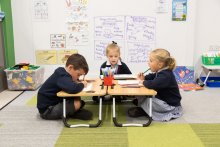
We are extremely lucky that Hazelwood School is a setting that encourages peer-on-peer learning and teaching. This is very valuable because it fosters a collaborative environment where teachers benefit from shared knowledge and diverse perspectives. Teachers with specialist qualifications can offer insights that are tailored to the needs of their peers, making learning more relevant and practical. This approach allows educators to engage in continuous professional development by exchanging ideas and strategies that directly impact their teaching practices. Peer teaching also promotes a sense of community, building trust and enhancing teamwork among educators.
Developing Strong Communicators
Dialogic teaching is an approach that emphasises open, meaningful conversation between students and teachers and is increasingly recognised as a powerful method for enhancing learning in the classroom. Although it has been a well-established practice in secondary education, it is now making its way into the lower school environment, where its impact is proving to be just as significant. Dialogic teaching fosters an environment where children are encouraged to engage in thoughtful discussions, develop their communication skills, and participate in learning that is both interactive and reflective. This approach not only nurtures critical thinking but also equips children with the social and emotional skills they need for respectful dialogue, which they will carry with them throughout their lives.
In a classroom in which the dialogic approach is fostered, students learn the art of communication by discussing, debating, and expressing their thoughts and ideas in a safe, supportive environment. Unlike a very traditional, teacher-centered classroom, where the teacher talks and the students listen, dialogic teaching invites all students to actively contribute to the learning process. This type of interaction allows children to hear different perspectives, ask questions, and provide thoughtful responses.
Nurturing Skills for the Future
In a lower school, children are at a developmental stage where social skills and emotional intelligence are forming, making it an ideal time to cultivate effective communication. By encouraging students to talk to one another and share their ideas, dialogic teaching helps children develop the confidence to express themselves clearly and respectfully. It creates opportunities for students to listen carefully to others, developing their ability to understand and appreciate different viewpoints. This process is essential not only for academic success but for life.
As children grow older, they learn to disagree, agree, and even challenge one another in a respectful manner. Dialogic teaching encourages students to engage in this type of constructive disagreement, which is a key skill in both academic and real-world settings. In a classroom where students feel free to voice their opinions, they are better equipped to consider alternate viewpoints, refine their thinking, and come to a deeper understanding of the topic at hand. Disagreements in a dialogic classroom are seen not as obstacles to learning but as opportunities for growth. Students learn to disagree without disrespect, a skill that is invaluable in all areas of life and it can be argued admirably equips them for the workplace.
A Collaborative Approach
Another key aspect of dialogic teaching is its emphasis on building connections between ideas. In a dialogic environment, students are encouraged to link their responses to what others have said, building on each other’s contributions. This collaborative approach to learning promotes deeper thinking and helps children see how ideas are connected. By building on one another’s ideas, students are able to make more meaningful connections and enhance their understanding of the material. For example, during a discussion about a story they are reading, one child might point out a character’s behaviour, while another might link that behaviour to a theme in the book. A third child might then offer a personal experience that relates to the theme. Through this collaborative process, students not only learn from the teacher but also from one another. This peer-to-peer learning helps solidify concepts and encourages children to see the value in contributing to group discussions.
A dialogic teaching approach encourages students to summarise, reflect on, and clarify their thinking. Summarising allows students to consolidate what they have learned, while reflecting gives them the opportunity to think critically about their ideas and how they have developed during the discussion. When children are asked to summarise or clarify their thoughts, they must organise their ideas in a coherent way, reinforcing their understanding of the material. This process also helps children become more aware of their thinking and strengthens their metacognitive skills.
A Highly Effective Strategy
Incorporating dialogic teaching into lower school classrooms is a highly effective strategy for fostering a positive learning environment. It is a teaching method that aligns with the developmental needs of young learners by focusing on communication, collaboration, and critical thinking. As children engage in meaningful dialogue, they build essential skills that will serve them throughout their education and beyond. In lower school, where foundational social and cognitive skills are being developed, dialogic teaching provides a powerful way to support not only academic growth but also personal and social development. By embedding this approach into the curriculum, we are preparing children for a future where communication, respect, and critical thinking are essential for success.
It is an absolute pleasure to help educators learn about a dialogic approach, having myself been so lucky to be under the expertise of many experts including Dr. Sara Hennessy and Professor Neil Mercer. Hazelwood’s Lower School is fully committed to embedding dialogic teaching and we are all looking forward to seeing the children flourish as their communication skills blossom!
Georgina Morgan
Head of Year 2





%20(1).jpg?command_1=resize&width_1=430&height_1=430)




